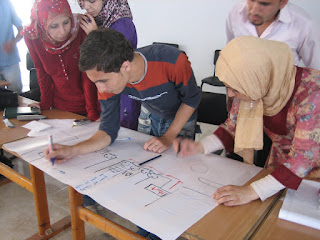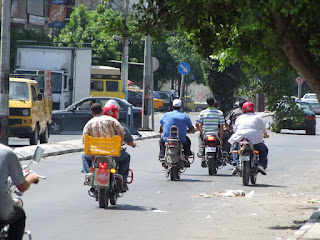 Voices Beyond Walls conducted its first ever 3-day Training of Trainers (ToT) course on participatory digital media and storytelling with youth at the Canaan Institute of New Pedagogy in Gaza City from June 28-30, 2010. The ToT was led by Dr. Nitin Sawhney, with assistance from Asmaa Al Ghoul, an award-winning writer and journalist in
Voices Beyond Walls conducted its first ever 3-day Training of Trainers (ToT) course on participatory digital media and storytelling with youth at the Canaan Institute of New Pedagogy in Gaza City from June 28-30, 2010. The ToT was led by Dr. Nitin Sawhney, with assistance from Asmaa Al Ghoul, an award-winning writer and journalist in While we expected around 20-25 participants, we were surprised to see around 36 young men and woman coming to attend all 3 days of the course. They all had prior experience working on creative programs with youth in local community centers including Canaan, Tamer Institute, Sharek Youth Forum, Right to Play, and the EJE woman and children’s centers in Gaza
Day 1: Youth Media, Photography and Neighborhood Mapping
 We began the first day with introductions among all participants, discussing the goals of the training and subsequent youth media workshops with community centers in
We began the first day with introductions among all participants, discussing the goals of the training and subsequent youth media workshops with community centers in These creative works served to provide a unseen window into issues faced by the children, even among their own communities indicated by the concerns brought up including preserving historical sites, violence in schools, family problems, and reflections on the occupation through poetry, photography and dramatic narrative.
In the afternoon, the photography session was led by Mohamed Albaba, a professional photo-journalist with Agence France-Presse (AFP), which sparked a great discussion of creative photo techniques to use with children. Mohamed showed some of his striking photography from Gaza , while Nitin discussed photo examples taken by youth and by Anne Paq, who leads similar photo workshops with Voices Beyond Walls in the West Bank .
The participants than had a chance to conduct hands-on exercises on neighborhood mapping in six small groups. Each team spent an hour or so exploring an issue in a neighborhood of Gaza City Gaza Gaza
With the regular electricity cuts in Gaza and intermittent diesel generators, there were only moments of power available during the sessions each day, so the rooftop room at Canaan remained unusually hot and we often struggled to run the video projector and video conferencing sessions with our counterparts in Ramallah. A brief video session with Raed, Anne and their Ramallah team at the end of the day exciting for everyone.
Day 2: Drama, Acting and Storyboarding
 The second day began with a drama session conducted by Jehan, a professional drama trainer from Tamer (who was also a participant in the course). She led all participants through a series of creative ice-breakers using their bodies, movement and enacting funny scenarios in groups to open up their creative energy. She felt that such exercises allow children (and adults) to improve group dynamics, express themselves in new ways and open up improvisational narrative techniques. Jehan had participants perform gestural action in 4 small squares depicting emotions like happiness, sadness, anger and pain, both individually and in groups. She later gave narrative cues to each group to enact improvisational plays, which including miming (with a devil and angel), following shadows and alter egos (between 2 participants dressed in black and white), and dance performances (“dabke”) in a traditional Palestinian wedding.
The second day began with a drama session conducted by Jehan, a professional drama trainer from Tamer (who was also a participant in the course). She led all participants through a series of creative ice-breakers using their bodies, movement and enacting funny scenarios in groups to open up their creative energy. She felt that such exercises allow children (and adults) to improve group dynamics, express themselves in new ways and open up improvisational narrative techniques. Jehan had participants perform gestural action in 4 small squares depicting emotions like happiness, sadness, anger and pain, both individually and in groups. She later gave narrative cues to each group to enact improvisational plays, which including miming (with a devil and angel), following shadows and alter egos (between 2 participants dressed in black and white), and dance performances (“dabke”) in a traditional Palestinian wedding.Nitin led a session on storyboarding with creative writing assistance from Jehan and Asmaa, to get all groups to develop unique narratives for their “1-minute films” as part of the training. The groups presented five main storyboards at the end, with critical discussion of the story characters, plot, unexpected climax and humor. Their stories dealt with everything from the funny life of a light post on the street, to a blind man who faked his blindness, a school kid who brought home the wrong mark sheet angering his mom, boys scared of hearing voices in an old home, and being traumatized by a stop sign (as a metaphor for the occupation). The critical review among the groups helped refine the story plots, though the groups preferred to improvise their scenes while shooting.
At the end of the day, Nitin handed out video cameras to all five groups to being shooting their films the following day.
Day 3: Child Rights, Video Shooting and Editing
 On the last day of the training we began with an introduction to the subject of children’s rights led by Bhassam Al-Agra, head of the training unit at the Palestinian Center for Human Rights. The goal of the session was to infuse serious understanding of child rights in youth media workshops to better support children in their awareness, expression and advocacy of critical issues and civic action, both in their own communities and internationally. Bassam discussed the international Convention for the Rights of the Child and the complementary Palestinian Child Law as is currently understood and enforced in the
On the last day of the training we began with an introduction to the subject of children’s rights led by Bhassam Al-Agra, head of the training unit at the Palestinian Center for Human Rights. The goal of the session was to infuse serious understanding of child rights in youth media workshops to better support children in their awareness, expression and advocacy of critical issues and civic action, both in their own communities and internationally. Bassam discussed the international Convention for the Rights of the Child and the complementary Palestinian Child Law as is currently understood and enforced in the  Participants discussed creative ways to make children more aware of their rights in the workshops to jointly develop to their own "bill of rights and responsibilities" as child journalists/videographers. They would then make "Press Passes" - IDs worn during filming, with their center info. and the rights listed in the back. This would give them a sense of responsibility and keen awareness of rights as part of the workshops.
Participants discussed creative ways to make children more aware of their rights in the workshops to jointly develop to their own "bill of rights and responsibilities" as child journalists/videographers. They would then make "Press Passes" - IDs worn during filming, with their center info. and the rights listed in the back. This would give them a sense of responsibility and keen awareness of rights as part of the workshops. We then had 5 groups go out for an hour of video shooting outdoors. Subsequently, Nitin conducted an editing session for all, with the VideoStudio editing software installed on their laptops. The overall shooting and editing went far better than we expected; we were impressed that most participants picked up editing so quickly. Their final “1-minute” films were funny, smart and creative; the group screenings were hilarious, after the brief videocon with Ramallah.
We then had 5 groups go out for an hour of video shooting outdoors. Subsequently, Nitin conducted an editing session for all, with the VideoStudio editing software installed on their laptops. The overall shooting and editing went far better than we expected; we were impressed that most participants picked up editing so quickly. Their final “1-minute” films were funny, smart and creative; the group screenings were hilarious, after the brief videocon with Ramallah.After the screenings, we had a chance to review the curricula plans for the main workshop to be held in Jabaliya camp in Gaza Gaza
Finally, we handed out "36" diplomas to all participants and took group photos thereafter. In the end, Nitin was asked to perform a brief "Bhangra" number as promised and all participants were psyched about their short films and looked forward to conducting such workshops in their own community centers.
The Gaza ToT was a huge success and many of the organizations involved (Tamer, Sharek and Canaan ) expressed a deep satisfaction with the outcomes for their own trainers. We thank them for their enthusiastic support of the Voices Beyond Walls program in Gaza






No comments:
Post a Comment